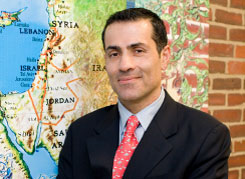Shaky Footing
With declining groundwater levels surrounding their pilings, buildings in many Boston neighborhoods could become dangerously unstable. Now Tufts engineers are looking to shore them up
By Marjorie Howard
Many of Boston’s buildings are on shaky ground—literally. That’s because many of the city’s neighborhoods were created out of fill, culminating in the creation of Back Bay by 1890. To keep the buildings from sinking, wooden pilings were driven deep into mud to support them.

“There is a concern for the structural integrity of the buildings,” says Professor Richard Vogel, left, who is working on the groundwater project with Brian Thomas, E14. Photo: Alonso Nichols
Those original wooden pilings still survive, but must be covered by groundwater to keep from rotting. If exposed to air and bacteria, the wood degrades and the buildings on top settle, creating cracked walls, window frames and stairways—and ultimately dangerous conditions.
Both the problem and the solution sound straightforward. However, it’s not always clear whether the groundwater is in fact covering the vulnerable pilings. Now the Boston Groundwater Trust, a city agency created in 1986, has hired Richard Vogel, a professor of civil and environmental engineering, to develop a computer model that will help determine what’s really going on. Joining him is Brian Thomas, E14, a doctoral student in statistical hydrology.
“There is a concern for the structural integrity of the buildings,” says Vogel, who is also the newly appointed director of the interdisciplinary graduate program Water: Systems, Science and Society.
One of the trust’s key accomplishments has been to add a zoning law, the Groundwater Conservation Overlay District, requiring that whenever buildings or their associated land parcel in the affected areas are modified, a perforated tank called a drywell must also be installed. Basically like a large rain barrel, the drywell collects rainwater, stores it underground and allows it to seep out gradually. The idea is that this recharges the groundwater system, says Thomas. “In the past, that water would have gone into a gutter and probably a storm drain, thus unavailable to the underground groundwater system,” he says.
A Nasty Engineering Problem

Without adequate groundwater to cover pilings supporting them, buildings such as this one become structurally unsound.
But no one is certain that the drywells are working as planned. “Having done all this for the last five or so years, the question is, have these recharge facilities improved the groundwater levels?” asks Vogel. “Our challenge is to filter out that effect from other effects, such as rainfall and leaky underground pipes.”
It’s a complicated endeavor. Groundwater levels are also affected by the level of the Charles River and influxes of storm water, not to mention the maze of infrastructure beneath Boston’s streets: gas, sewer, water and telephone lines, as well as steam pipes and the subway. Pipes that are no longer in use make up yet another part of the equation.
“It’s a very nasty real-world engineering problem, because of all the complexities that either curtail or enable the flow of water,” Vogel says. “A leak in a water supply pipe contributes to the groundwater, which in some ways you want. But you don’t want leaks in storm water pipes, which are often empty, because such leaks drain into the pipes instead of the groundwater system.”
There are now more than 800 groundwater wells in Boston, which are monitored by the Trust each month. In addition, 69 active groundwater recharge systems have been installed since 2006.
“If we’re successful in building a computer model,” says Vogel, “it will enable the Boston Groundwater Trust to plan for the future by quantifying the impact of these recharge methods on future groundwater levels. They’re trying to figure out whether they solved the problem; this approach should help them determine that.” The project began in September and initial results are expected by September 2010.
The engineers will use a combination of techniques, including statistical trend detection methods developed by Ellen Douglas, E02, an assistant professor of hydrology at the University of Massachusetts at Boston who received her Ph.D. at Tufts under Vogel’s direction.
Vogel’s students are getting in on the act, too. Thomas says the research will be a chapter in his doctoral dissertation. And in his undergraduate classes, Vogel’s students have worked on creating computer models for the groundwater system, as has a graduate student in his class in environmental statistics.
Marjorie Howard can be reached at marjorie.howard@tufts.edu.

